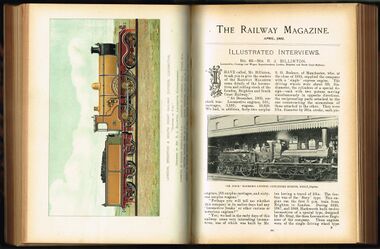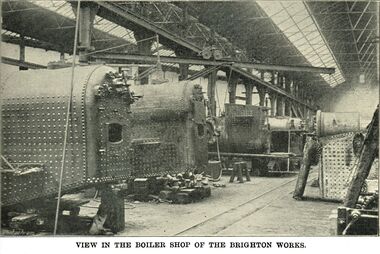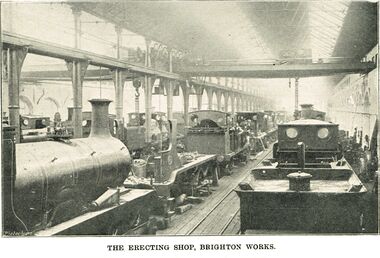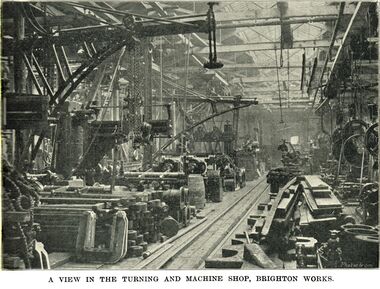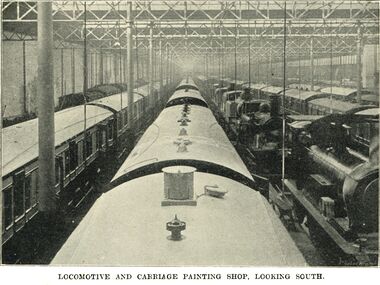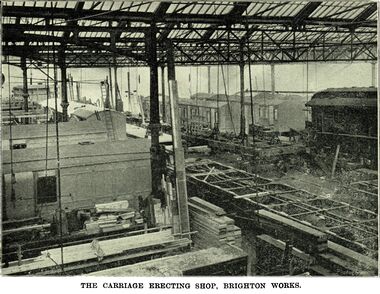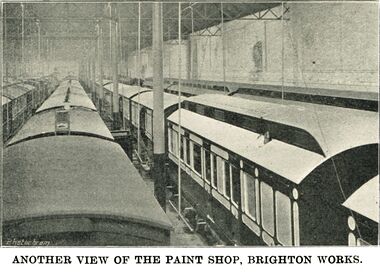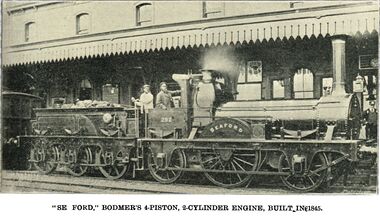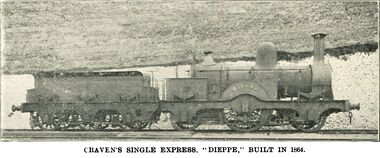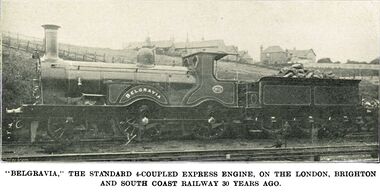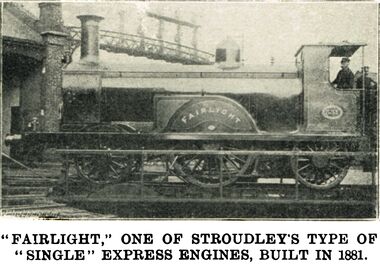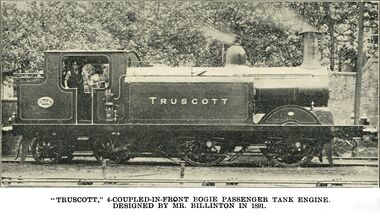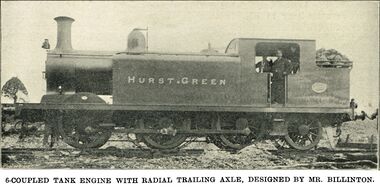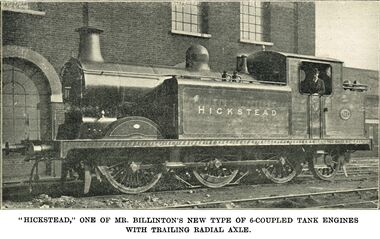Brighton Works, described by R J Billinton (TRM 1903)
1903: Billinton interview [image info]
Boiler Shop, Brighton Works [image info]
Erecting Shop, Brighton Works [image info]
Turning and Machine Shop, Brighton Works [image info]
Locomotive and Carriage Painting Shop, Brighton Works [image info]
Carriage Erecting Shop, Brighton Works [image info]
Another view fo the Paint Shop, Brighton Works [image info]
1845-built "Seaford" locomotive [image info]
1864-built "Dieppe" locomotive (Craven) [image info]
1872-built "Belgravia" locomotive [image info]
1881-built "Fairlight" locomotive (Stroudley) [image info]
1892-built "Truscott" locomotive (Billinton) [image info]
1898-built "Hurst Green", LBSCR 465 (Billinton) [image info]
1903-built "Hickstead", LBSCR 571 (Billinton) [image info]
An interview with R.J. Billinton regarding the then-status of the LBSCR and Brighton Works, conducted by G.A. Sekon, Founding Editor (real name: George Augustus Nokes), and published in The Railway Magazine in 1903.
The Railway Magazine (April 1903) Illustrated Interview No.40 - Mr. R.J. Billinton (Locomotive, Carriage and Wagon Superintendent, London, Brighton and South Coast Railway)
I HAVE called, Mr. Billinton, to ask you to give the readers of the RAILWAY MAGAZINE some details of the locomotives and rolling stock of the London, Brighton and South Coast Railway."
"At December, 1902, our stock was: Locomotive engines, 535; carriages, 3,183; wagons, 10,028. We had, in addition, forty-two surplus Engines, 201 surplus carriages, and sixty-one surplus wagons."
"Perhaps you will tell me whether this company in its earlier days had any 'locomotive freaks' or other curious or notorious engines?"
"Yes; we had in the early days of this Railway some very interesting locomotives, one of which was built by Mr. S. G. Bodmer, of Manchester, who, at the close of 1845, supplied the company with a 'single' express engine. The driving wheels were about 5ft. 9in. diameter, the cylinders of a special design – each with two pistons moving simultaneously in opposite directions, the reciprocating parts attached to the one counteracting the momentum of those attached to the other. They were 15in. diameter by 20in. stroke, each piston having a travel of 10in. The firebox was of the 'Bury' type. This engine ran the first 5 p.m. train. from Brighton to London. During 1846, 1847, and 1848, Hackworth built twelve locomotives of a special type, designed by Mr. Gray, the then Locomotive Engineer of the company. These engines were of the single driving wheel type and had a novel expansive valve gear, known as the 'horseleg motion,' patented by Mr. Gray, who employed a species of link, and by an elaborate arrangement of reversing gear the end of either eccentric rod could be engaged in its corresponding curved groove, there being two grooves each on opposite sides of the link. The eccentric rods, moreover, could be adjusted to give their motion to an arm at variable distances from the axis upon which it vibrated, which arrangement varied the travel of the valve and also the lead at the same time, and where there was already considerable lap the variation proceeded more rapidly than the variation in the travel of the valve.
"Two of these engines were converted to Crampton's principle. That system had no wheels on the crank axle, which was connected with the trailing wheels by a coupling rod, which really means the trailing wheels were the driving. Needless to say, these engines proved far from satisfactory.
"The famous 'Jenny Lind' engines, which were so numerous on all the principal British railways, were designed specially for the Brighton Railway."
"That is so; Mr. David Joy, who has just died, had a good deal to do with the 'Jenny Lind' design. It is generally known that you succeeded Mr. Stroudley as Locomotive Superintendent, but I believe at the time you became chief there were still some engines of an earlier design at work?"
"Yes, there were several engines of Mr. Craven's design some few years ago on some of the lighter trains and on the branches, but owing to the ever-increasing loads they had to be put out of service. Among these were some six-coupled engines, built by the Avonside Engine Company, and although quite thirty years old the boilers were in very fair condition."
"Have you now disposed of all Mr. Craven's locomotives?"
"Yes, the last of Mr. Craven's engines, No. 6141, a six-coupled goods engine, built in 1866, was scrapped in July, 1901, but for some time previously the boiler, still mounted on its frames and wheels, supplied steam to a pumping engine at one of our out-stations."
"This brings me to a question of some interest, viz., the fact that many of the small provincial railways apparently look to the London, Brighton and South Coast Railway as the source of their locomotive power. Am I right in assuming that it is the practice of the London, Brighton and South Coast Railway to sell its older engines and vehicles for use elsewhere rather than 'scrapping' them?"
"No. I think you are wrong in assumhg that certain railways look to us for supplying locomotive power. It is our general practice to sell locomotives that are no longer fit for service to old metal merchants, but some time back we did sell – owing to the fact that the work was getting too severe for this class – some of the small six-coupled passenger tank engines to a railway in the South and some to a railway contractor."
"Now as regards Mr. Stroudley's types of engines, they differed very considerably from the various classes of locomotives you have designed for the London, Brighton and South Coast Railway, so perhaps you will let RAILWAY MAGAZINE readers have the benefit of your views on the distinguishing features of Mr. Stroudley's designs?"
"Owing to the demand for increased locomotive power and higher speeds over the various sections of the line, which have some severe curves, it was decided to construct powerful engines having a leading bogie, with large cylinders having the slide valves underneath. The increased speeds required a larger diameter of coupled wheels, and, conseqnently, a much higher pitched boiler. Engines constructed with these modifications have been doing very good work, but a large portion of the work on this line is dome by tank engines."
"Your views an the subject are certainly most interesting, Mr. Billinton. How many engines of each type were there when you took charge, and what are the present numbers of these types?"
"When I took charge of the Locomotive Department in January, 1890, there were 410 engines comprising nine standard classes of locomotives and two or three odd engines of special design. There were fifty of the 'A' class, that is, of the small six-coupled passenger tanks; thirty-six of the 'B' class, the well known 6ft. 6in, leading and driving wheels coupled express engine; twenty of the 'C' class, a powerful six-coupled goods engine; also thirty-two of a larger and more modern type of goods engine; there were 125 of the 'D' class passenger tanks; thirteen of the 'D2' of mixed traffic sender engine, this class being almost identical with the 'D' class, but having tenders in lieu of tanks; there were six of the 'D3' class of Stroudley's earlier type of large leading coupled passenger engines; of the 'E' class, which is a six-coupled goods tank engine, there were seventy-eight, and twenty-six of the 'G' class, the single driving wheel express engine. Most of these engines are in service, excepting a very few which have been found unequal to the heavy demands that the increased traffic calls for."
"We have now cleared the way for details of the many typos of modern locomotives you have designed for the London, Brighton and South Coast Railway. Your initial type was, I believe, a four-coupled tank engine with a trailing bogie?"
"Yes, after all the locomotives which were on order when I came to Brighton in 1890 were finished, designs were prepared for a four-coupled bogie tank engine, of which class the first came out in June, 1893, there now being thirty-six, which have proved to be a very serviceable type both in the suburban and country districts. The cylinders are 18in. by 26in., coupled wheels 5ft. 6in. diameter, and the weight in working order 48½ tons."
"Was not such a design a novelty on the London, Brighton and South Coast Railway?"
"Well, the class was not an absolute novelty on this line. Mr. Craven designed and constructed as far back as June, 1859, an experimental engine for the West End of London line, having a leading bogie, outside cylinders and four coupled wheels. It was, I believe, the first engine of this class to be so constructed embracing these features. Another outside cylinder tank engine with leading bogie was built, at Brighton in 1861. In October, 1866, another type of bogie tank was constructed, having the leading and driving wheels coupled and a trailing bogie. So you will see by this it is over forty years ago that the first bogie tank engine was built for this line."
"Particulars of your succeeding types. if you please, Mr. Billinton?"
"Following the bogie tanks came the six-coupled goods engine, having 5ft. wheels and 18in. by 26in. cylinders, wih 1,211.69 square feet of heating surface in the boiler. The weight of this class of engine in working order is 70 tons. These engines, of which there are fifty-five, have all been built by the Vulcan Foundry Company. This class was followed by the six-wheel-coupled radial tank engines; there are sixteen 01 this type, and they have 4ft. 6in. diameter wheels, 18in. by 26in. cylinders, the boilers have 1,199.44 square feet of heating surface, and their weight in working order is 51 tons. A similar class, but with wheels 5ft. diameter, has since been built, of which we have sixty-nine. These engines certainly were followed by a novelty for this line, by the introduction of a four-coupled bogie express. These have 18in. by 26in. cylinders, and coupled wheels 6ft. 9in. diameter, the heating surface of the boiler being 1,342.08 square feet, and the weight in working order 75 tons 6 cwts."
"Then as to your latest designs?"
"Our latest design of express engine is the 'Empress' Class, one of which, the 'Duchess of Fife,' you illustrate in colours in this issue of the RAILWAY MAGAZINE. Of this type there are at present thirty-three at work. These engines have cylinders 19in. diameter, 26in. stroke, and 1,650 square feet of heating surface. Their weight in working order is 77 tons 7 cwts."
"Have you any new types under construction or in contemplation?"
"Yes, we have at the present time under construction (a few of which are running) some six-coupled radial passenger tank engines, having 18in. by 26in. cylinders, the heating surface being 1,211.69 square feet, diameter of the six coupled wheels 5ft. 6in, and their weight is 57 tons 10 cwt. I have in contemplation a larger class of express engine to meet with the demands of the ever-increasing loads."
"What about the passenger rolling stock? Travellers cannot fail to notice that during recent years there has been almost a revolution in the character of the coaching vehicles on the London, Brighton and South Coast Railway."
"During the last few years we have been building bogie stock rather extensively. The coaches have the roofs higher pitched than formerly, thus giving better ventilation. Gas and electric light have supplanted the primitive oil-lamps. We have a great number of composite and lavatory carriages, and have also introduced lavatories into the third-class carriages. We have for several years past built some very fine close-coupled bogie suburban trains, and have under contemplation building some suburban trains 9ft. wide to give increased accommodation, but with such wide vehicles we should necessarily have to revert to the four-wheeled type of coach. The number of Pullman cars running in the main line trains has also been increased, all of them being put together and finished in the Brighton Works."
"I have noticed that from time to time you have been experimenting with different colours for the carriages. Have you arrived at any definite decision as to what is to be the 'distinctive livery' of the London, Brighton and South Coast Railway?"
"It has not yet been definitely decided to change the colour of the carriages, although several varieties of colour have been tried, one of which is that the lower half is painted a dark umber, and the upper half a pale drab, picked out with orange lines, but there is a feeling that a colour similar to that of the Pullman cars is suitable for the top and waist panels, being lightened in the same shade as to the lower panels, with the usual lettering, but at present the matter is not decided."
"Some details of the Brighton Works would be of interest, Mr. Billinton."
"With regard to the works, I may say we are greatly handicapped by their smallness, it being very difficult to keep pace with the constantly increasing repairs. The main erecting shop is about 385ft. by 84ft., and we can repair about forty-five engines at a time. In the erecting shop we have four 25-ton overhead travelling cranes, driven by endless ropes. The new erecting shop is 165ft. by 42ft. We have just built a new steel underframe shop 125ft. long, by 32ft. wide, this shop has two 6-ton endless rope cranes. The boiler shop is 315ft. long by 100ft. wide, and has two 12-ton overhead cranes driven by endless rope. The boiler shop is fitted with the latest hydraulic riveting machinery and portable pneumatic drilling machines. The smithy is 215ft. long by 115ft. wide. The fitting and machine shop is 210ft. long by 120ft. The paint shop is 780ft. long by 190ft. wide. An addition has been made to the wheel shop, also to the wheel and axle turnery and spring shop. The fitting and machine shop at the present time is being considerably enlarged. A short time ago a new shop for carriage lifting was erected at Preston; this is also used for testing air-brakes on carriage stock. In addition we have a portable testing van for this. purpose, which is always attached to the shunting engine."
"We employ over 2,000 hands, 173 being employed in the erecting shop, 269 in the machine shop and turnery, wheel shop 145, smith's shop 104, boiler shop 326, foundry 52, carriage shop 112, saw-mill 30, paint shop 503, wagon shop 75, trimming shop 79, and 12 in the pattern shop."
"About 114 engines are stationed at Brighton, about 100 drivers, and about the same number of firemen."
"Since you have been at Brighton you have considerably increased the machine tools, I believe?"
"Yes, the increased work of the last few years has necessitated out putting down a considerable number of new machines comprising machinery for morticing, turning wheels and axles, steam hammers, double and multiple drilling machines, boring, milling, shaping, cylinder boring, combined drilling and milling, planing small lathes, automatic stud screwing and bolt making, heavy milling and bending machines."
"Is the removal of at least a portion of the establishment contemplated?"
"It has for some time been under contemplation to remove the Carriage and Wagon Department to a suitable site at Lancing, situated between Shoreham and Worthing."
"In addition to the works at Brighton I understand that repairs are carried out at Battersea and New Cross?"
"That is so; the shops at New Cross, excepting those used for carriages, being the original ones of the London and Croydon Railway, which was amalgamated with this company in 1847.
"Both New Cross and Battersea have facilities for undertaking ordinary running shed repairs."
"In addition to the large locomotive sheds at Brighton, Battersea and New Cross, what are the other important ones on the system?"
"Horsham, Fratton, Eastbourne, St. Leonards, Tunbridge Wells, and Three Bridges."
"There are, of course, smaller sheds at other stations?"
"Yes, we have also running sheds at West Croydon, Epsom, Dorking, Midhurst, Bognor, Littlehampton, Newhaven and Stoats Nest."
"Have you also the upkeep of the marine engines under your charge, Mr. Billinton?"
"There is a workshop at Newhaven, and in conjunction with the Brighton Works the repairs are carried out; but the staff at Newhaven is under the charge of the Marine Superintendent."
"Does any other branch of the Mechanical Engineering Department come under your care?"
"Yes, we maintain all turn-tables, shop machinery, water cranes and hydraulic machinery, pumping engines, weighing machines and steam portable cranes, also the road vans belonging to the Goods Department, and the engines and boilers used for electric lighting and the manufacture of gas for the carriages."
"And now, Mr Billinton, something about yourself, please?"
"I commenced my business career in the works department of the late Sir William Fairbairn, the well known Engineer of Manchester. Upon leaving 'Cottonopolis,' I joined the engineering staff of the late Mr. James Simpson, in London; then for several years I had a wide, general experience in the shops of various engineers who do contract work, more especially in steel plant and general engineering work."
"Then, as to your railway career. I understand you were some years at Derby before joining the London, Brighton and South Coast Railway?"
"Yes, that is so, Mr. Sekon. I was with the Midland Railway, for a number of years, going to Derby in 1874; but previously, from 1870 to 1874, I was assistant to the late Mr. Stroudley, the Locomotive Superintendent, of this railway, and upon his decease in December, 1889, I returned to Brighton, and succeeded him as Locomotive, Carriage and Wagon Superintendent of the London, Brighton and South Coast Railway."
"Many, many thanks, Mr. Billinton, for the trouble you have taken in supplying so much interesting information. I am sure RAILWAY MAGAZINE readers will as fully appreciate your courtesy as I do. Good-bye."
G.A. Sekon
— , R.J. Billinton, , The Railway Magazine, , 1903
